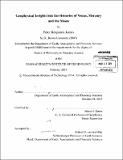Geophysical insights into the histories of Venus, Mercury and the Moon
Author(s)
James, Peter Benjamin
DownloadFull printable version (12.23Mb)
Other Contributors
Massachusetts Institute of Technology. Department of Earth, Atmospheric, and Planetary Sciences.
Advisor
Maria T. Zuber.
Terms of use
Metadata
Show full item recordAbstract
Gravity and topography data provide a powerful tool for studying the interiors of rocky planetary bodies. In this thesis I study three such bodies - Venus, Mercury and the Moon - and I use the gravity and topography data returned by recent NASA planetary science missions to model their structure and evolution. I calculate geoid/topography ratios on Venus using gravity and topography data from NASA's Magellan mission. These ratios inform models of crustal thickness and mantle density, which in turn have implications for the formation of Venus's highland crust. I perform spatio-spectral localization of gravity and topography on Mercury from the MErcury Surface, Space ENvironment, GEochemistry, and Ranging (MESSENGER) mission, and I perform analytical calculations of two layered mantle flow in order to interpret the high low degree admittances associated with Mercury's domical rises. Finally, I use lunar gravity from the Gravity Recovery And Interior Laboratory (GRAIL) mission along with topography from the Lunar Orbiter Laser Altimeter (LOLA) to quantify the stress state in the nearside maria, thereby placing constraints on the Moon's thermal evolution.
Description
Thesis: Ph. D., Massachusetts Institute of Technology, Department of Earth, Atmospheric, and Planetary Sciences, 2014. Cataloged from PDF version of thesis. Includes bibliographical references (pages 143-155).
Date issued
2014Department
Massachusetts Institute of Technology. Department of Earth, Atmospheric, and Planetary SciencesPublisher
Massachusetts Institute of Technology
Keywords
Earth, Atmospheric, and Planetary Sciences.